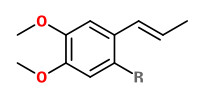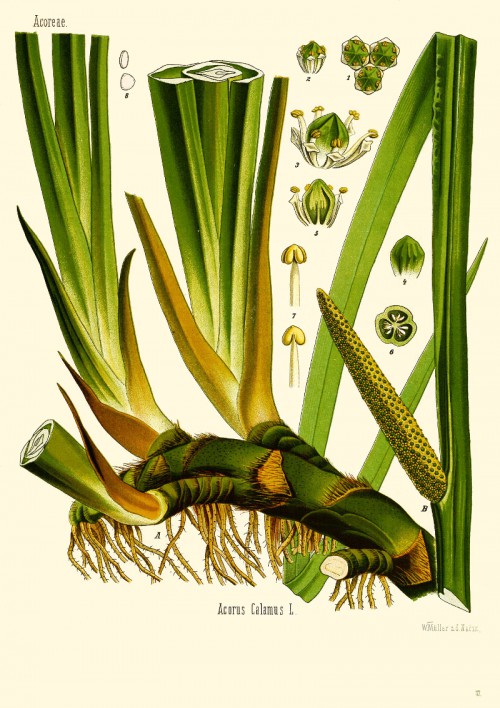Dies ist eine alte Version des Dokuments!
Acorus calamus L. - Araceae - sweet flag, calamus, flagroot, myrtle flag, Kalmus
Perennial from stout, creeping, aromatic rhizomes, native to eastern Europe, central Asia, India; leaves linear, erect, margins waved, 0.90-1.80m long, crowded at base; scape resembling the leaves, prolonged into an erect green spathe; spadix hard and dense, 5-10cm long, 1cm thick at anthesis, 2cm at maturity, covered with yellowish brown flowers.
„The flowers have a putrid smell, but the plant as a whole has a strong, aromatic odour, especially noticeable when the leaves are broken.“
http://www.bojensen.net/EssentialOilsEng/EssentialOils05A/EssentialOils05A.htm
Four varieties:
A. calamus var. americanus Raf. (american, diploid, no β-asarone), (= A.calamus var. americanus Wulff?)
A. calamus var. vulgaris L. (european, triploid, 0.3% β-asarone), (= A. calamus var. calamus L. ?)
A. calamus var. verus L. and A. calamus var. angustatus Bees (= A. calamus var. angustata Engler? , both verus and angustatus tetraploid, containing up to 8% β-asarone)
[Biosystematic investigations with Acorus. 4. A synthetic approach to the classification of the genus., Rost, L.C.M., Planta med, Vol.37, 1979, 289-307]
„Acorus calamus L. yields different races depending upon the number of chromosomes in the plant cells and consequently different drug types with varying content of β-asarone [= (Z)-asarone]. The phenylpropane derivative proved to be carcinogenic in several animal tests. The diploid drug does not contain traceable amounts of β-asarone, the triploid variety contains 0.3 per cent in the rhicome, the tetraploid yielded two races with a) 2% and b) between 4% and 8% β-asarone. For reasons of optimal drug safety the use of asarone-rich races should be avoided. They can be distinguished by a fast and safe method of determining the extinction of the drug extract at the β-asarone maxima of 253 and 303 nm.“
[To the classification of commercial Calamus drugs., Stahl, E., Keller, K., Planta medica, Vol.43(2), 128-140]
 (E)-asarone (R=OCH3, α-asarone) or (E)-methyl isoeugenol (isoeugenol methyl ether, R=H)
(E)-asarone (R=OCH3, α-asarone) or (E)-methyl isoeugenol (isoeugenol methyl ether, R=H)
Acorus calamus rhizome, Calamus: The dried rhizome and also the calamus oil are ancient remedies against gastro-intestinal disorders. The drug was introduced to Europe in the 16th century, coming from India. The rhizome is cutted into pieces after cleaning and dried at moderate temperatures (up to 35 deg.). Sometimes it is peeled before drying. Calamus has an aromatic odor, it tastes spicy, pungent and bitter.
Constituents. Volatile oil (1-5%, tetraploids also more) with more or less β-asarone, ranging from 0-82%, [CRC; Wichtl; Keller K, Stahl E, DAZ 122,(1982), 2463; Keller K, Stahl E, Planta Med 47,(1983), 71; Stahl E, Keller K, Planta Med 43,(1981), 128 ], or isoeugenol methyl ether as the main constituents, also the sesquiterpenes calamendiol and isocalamendiol. As mentioned above, the occurence of beta-asarone depends on the variety of calamus and is of great importance to users, as possible carcinogenic effects of the substance in man can not be excluded. [! Li M, Jiang Z, Variations of the essential oils in Acorus calamus L. and their major constituents, Zhongguo Zhonqyao Zazhi 19(5), (1994), pp.274-6) - also showing June to best the best season for A. calamus cropping].
Furthermore: tannine, bitter principles (acorone, isoacorone [and Kryptoacoron], as well as the glycoside acorine) and mucilage.
Indian scientists reported the isolation of acoradin, 2,4,5-trimethoxybenzaldehyde, 2,5-dimethoxybenzoquinone, galangin and sitosterol from A. calamus root rhizomes. [Patra A, Mitra AK, Constituents of Acorus calamus L., Indian J. Chem., Sect.B 17B(4), (1979), pp.412-14]
The steam distilled oil from Acorus calamus (yield 1.5-4.8%) owns a „…peculiar but pleasant, slightly sweetish, fatty odour reminescent of stale milk.“ A fraction of the oil (124-150°C/5 torr) contained several saturated and unsaturated aliphatic aldehydes C6-C10 and aromatic aldehydes like cuminic aldehyde, anisic aldehyde, and β-cyclocitral e.g. Of the decadienals found, (Z,Z)-4,7-decadienal (500ppm, odour threshold 4.2ppb) showed an odour most reminescent of calamus oil.
[Isolation and synthesis of (Z,Z)-4,7-decadienal, the character impact compound in the oil of Acorus calamus L., van Lier, F.P., van der Linde, L.M., van der Weerdt, A.J.A., Progress in essential oil research., 1986, 215-225]
 (Z,Z)-4,7-decadienal (calamus, green, fatty, rose-orris)
(Z,Z)-4,7-decadienal (calamus, green, fatty, rose-orris)
„The pale yellow to pale brown volatile calamus oil has an odor described as 'woody-spicy with increasingly sweet afternotes and great tenacity' that resembles 'dried milk or sweet leather, slightly creamy-nutty', and has been compared to the fragrance of a milk-truck or shoe-repair shop (Arctander 1960). This characteristic aroma is derived from the chemical compound (Z,Z)-4,7-decadienal which is present in the oil at about 100 000 times its odor threshold value (van Lier, van der Linde, and van der Weerdt 1986).“
[The ethnobotany of sweet flag, Acorus calamus (Araceae)., Motley, T.J., Economic Botany, Vol.48(4), 1994, 397-412] http://rbedrosian.com/Ethnob/Ethnob_1994_Sweetflag.pdf
„The essential oil of Acorus calamus L. roots obtained from Konya (Beysehir) was analyzed by GC/MS. Forty-three components representing 71.16% of the oil were identified. Preisocalamendiol (17.3%), isoshyobunone (13.0%), 1,4-(trans)-1,7(trans)-acorenone (10.5%), camphor (5.9%), 2,6-diepishyobunone (2.6 %) and β-gurjunene (2.5%) were the major constituents.“
[Özcan, M., Akgül, A., & Chalchat, J. C. (2002). Volatile constituents of the essential oil of Acorus calamus L. grown in Konya province (Turkey). Journal of Essential Oil Research, Vol.14(5), 2002, 366-368]
„The yield of calamus oil was in the range of 1.1-3.3% for SFE and 1.0-2.4% in the case of SDE. The extracts obtained by SFE contained mainly β-asarone (odorless !), isoshyobunone, shyobunone (fruity cowberry), preisocalamendiol, spirodecanone, acorenone, acarone. A comparison with the SDE oil did not reveal any big differences, except for acarone (13.3% versus 2.8%), acorenone (12.5% versus 22.4%), preisocalamendiol (15.7% versus 8.1%) and spirodecanone (5.1% versus 0.9%). Furthermore, some quantitative differences were observed not only between the extraction methods but also among the calamus samples, collected from different places.“
[Comparison of the essential oil composition of Acorus calamus obtained by supercritical carbon dioxide extraction and hydrodistillation methods., Gretšušnikova, T., Koel, M., Orav, A.]
http://www.isasf.net/fileadmin/files/Docs/Arcachon/posters/p153-P12%20full%20text.pdf
Effects. It was shown that alcohol extracts of Acorus calamus rhizomes are tranquilizing, sedative, spasmolytic, and that this pharmacological properties are very similar to the properties of asarone. [Vohora SB, Shah SA, Dandiya PC, Central nervous system studies on an ethanol extract of Acorus calamus rhizomes., J Ethnopharmacol, 28(1), (1990), pp.53-62; Belova LF, Alibekov SD, Baginskaja AI, Sokolov S, Pokrovskaja GV, Asarone and its biological properties, Farmakol Toxikol, 48(6), (1985), pp.17-20] Asarone is shown to have cancerogenic and mutagenic properties. [Wichtl;Taylor JM et al., Toxicol Appl Pharmacol, 10, (1967), 405; Gross MA et al., Proc Am Assoc Cancer Res, 8, (1970), 24; Habermann RT, Project P-153-70, Report of the FDA (1971); Goeggelmann W, Schimmer O, Mutat Res, 121, (1983), 191 ]
Convulsions induced by strychnine and acetylcholine-induced contractions of muscles are not blocked by an alcoholic extract, but caffeine citrat promoted contractions in frog are inhibited. Also negative ino- and chronotropic effects as well as sedation effects could be shown.
[Panchal GM, Venkratakrishna-Bhatt H, Doctor RB, Vajpayee S, Pharmacology of Accorus calamus L., Indian J Exp Biol, 27(6), (1989), pp.561-7]
Uses. Calamus rhizome, the volatile oil and the tincture are used to promote the secretion of gastric juice, to treat inappentence and flatulence. Folkloristic medicinal use include the treatment of nervous complaints like headache and neuralgia as well as the external treatment of rheumatism and skin deseases like seborrhea (as bath, unpeeled drug). Candied calamus was formerly taken as sweet. Calamus oil is also used as a fragrance component in products like perfume, soaps and baths. As decoction, 1.5g of the cutted rhizome is heated with 150ml (one cup) of water until boiling and left standing for 5 minutes. Take one cup half an hour before meal to promote appetite.
„Different parts of Acorus calamus L. (Araceae) and Asarum europeaum L. (Aristolochiaceae) growing in Poland were subjected to headspace-SPME (HS-SPME) and the same plant material were hydrodistilled (HD) to obtain the profiles of their volatile constituents. In both cases, compounds of essential oils and headspace volatiles were identified and quantified by GC and GC/MS. The results showed that the similar compounds were detected in the vapor phases and in the oils derived from both plants. The 68 compounds in the oil and 40 in SPME headspace of A. calamus were identified representing 99.3% and 97.3% of the total components detected, respectively. The main constituents of the oil of A. calamus were acorenone (14.6%), shyobunone isomer (10.5%) and (Z)-asarone (10.4%). The acorenone integrated with (E)-asarone (50.1%), 6,11-oxidoacor-4-ene (9.0%), iso-caryophyllene (8.6%) were found as the main constituents in the SPME phase of A. calamus.“
[Comparison of volatile constituents of Acorus calamus and Asarum europaeum obtained by different techniques., Wilczewska, A.Z., Ulman, M., Chilmończyk, Z., Maj, J., Koprowicz, T., Tomczyk, M., Tomczykowa, M., Journal of Essential Oil Research, 20(5), 2008, 390-395]

Köhler, F.E., Medizinal Pflanzen, vol.1, t.17 (1887) [W.Müller]
http://plantgenera.org/species.php?id_species=15928
